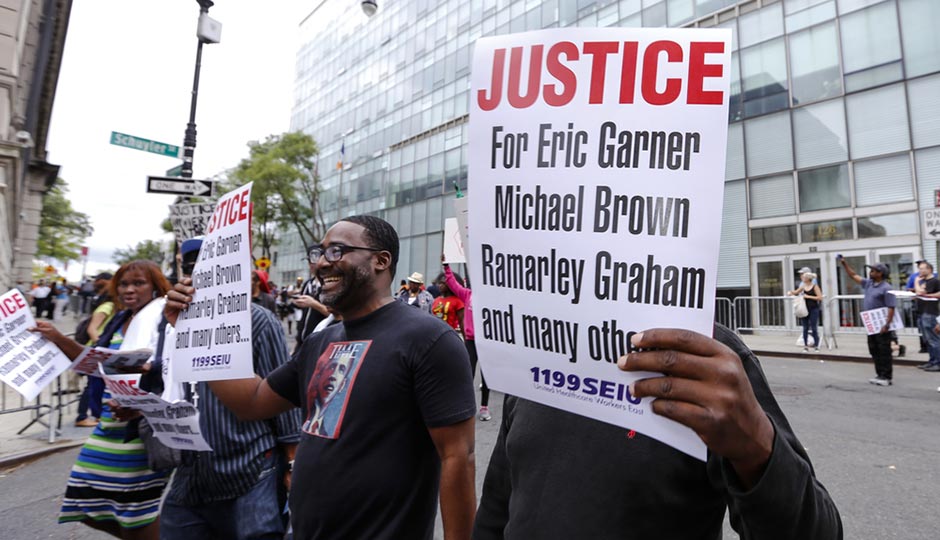Here’s What’s Missing From the #BlackLivesMatter Discussion
Francis: Police brutality is just the first item on the agenda.

NEW YORK CITY – AUGUST 23 2014: Thousands rallied in Staten Island demanding justice & accountability in the deaths of Eric Garner, Michael Brown & other victims of alleged police brutality a katz / Shutterstock.com
There are missing pieces in the coverage of Black Lives Matter.
Yes, putting an end to abuse of force by the police is a primary goal. But there are other systemic things that impede the quality of black life: Bad schools. Poor nutrition. Bad health. These things matter, too, but they’re not getting the attention of tragedy-porn dashcam video and police confrontations with protesters.
It’s time that we broaden our understanding of Black Lives Matter to include how the movement affects black lives that are still being lived, to address the issues that impact quality of life for blacks living in America.
The deaths of black youths have galvanized protesters and the children have become the barometer of the movement and how much work is left to be done. The legacy of redlining and its uneven distribution of resources impacts their access to basic needs, ranging from quality public education to quality produce.
So let’s talk about the rest of the agenda:
Schools
In schools — places that should be safe havens for young people as they achieve developmental and behavior milestones — black children are failed and learn early that they are identified as troublemakers.
An article in The Nation notes that “a study conducted by U.S. Department of Education Office for Civil Rights shows that black preschoolers … make up almost half of all out-of-school suspensions for preschoolers.”
Overcrowded classrooms, lack of available special education and counseling resources, under-qualified and/or overstretched teachers: These factors create environments for disengagement, particularly when the emphasis of the broader school system is on testing. Coupled with zero-tolerance policies, children of color are placed in the crosshairs of the prison industrial complex at an early age.
The takeaway: #BlackStudentsMatter.
Girls
It’s not just boys who face these problems. A report by NPR states that “Girls of color, and especially black girls, are subject to discipline that is harsher and more frequent than that of their white peers, and are six times more likely to be suspended than white girls. The racial disparities in punishment are greater for girls than for boys.” This not only sustains the achievement gap, but also makes plain that prison reform will not be so easily achieved.
“It is important to recognize that the double standards imposed on black girls are not limited to over-punishment,” says Kimberly Crenshaw Williams, whose research formed the basis of the NPR report. “Some stakeholders indicated that black girls are all too often overlooked for their accomplishments.” In other words: Young black women tend to be over-punished and under-praised.
The takeaway: #BlackGirlsMatter.
Nutrition
And these students, what are they eating at school? And what’s available to them in their neighborhoods? In low-income urban neighborhoods and rural spaces across the country where residents have fewer cars there is a lack of access to fresh quality goods.
I’ve worked in such neighborhoods as an educator, where the air of the lone supermarket greets shoppers with a putrid smell of questionable produce as the door opens. For sure, it makes the McDonald’s on the corner more enticing and the corner stores that dot street corners, chock-full of processed foods, seem like a quick fix.
According to the Food Empowerment Project, “Studies have found that wealthy districts have three times as many supermarkets as poor ones do, that white neighborhoods contain an average of four times as many supermarkets as predominantly black ones do, and that grocery stores in African-American communities are usually smaller with less selection.”
The impact on black children is immediate. “Centers for Disease Control and Prevention (CDC) has found that black and Hispanic kids have a 50 percent chance of developing diabetes, in comparison to the 40 percent chance that Americans have overall,” according to reports.
The takeaway: #BlackHealthMatters.
Public education, the school-to-prison pipeline, and food deserts are equally imperative issues that relate to value of black lives. “Stop killing us,” has been the battle cry of foot soldiers on the ground, but what does it mean to live, if living means little more than just surviving?
Yes, it is important that the police stop killing us.
But our kids need a fair chance at life, too.
Follow @MF_Greatest on Twitter.


